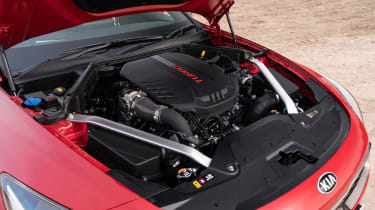Kia Stinger GT S (2017-2022) review – engine, gearbox and technical highlights
Sole 3.3-litre V6 and auto ’box are effective, but not particularly charismatic
So the Stinger range is now top and tailed by the 3.3-litre twin-turbocharged V6 engine, badged Stinger GT S. Designed to service multiple Hyundai Kia applications in overseas markets, it’s an engine that differs from European units by not really being designed for performance applications. As a result, it’s smooth, quiet and torque-heavy at low rpm, but also lacks the voice and ultimate response of the straight and V6 engines in admittedly more expensive German rivals.
So while it develops 365bhp at 6000rpm and 376lb ft of torque from 1300rpm all the way to 4500rpm, response can be a little soft, and despite the wide torque band, catch it in the wrong gear and it will take its time to get going. The transmission itself is also a little soft and unresponsive, often dropping too many gears when asking for more forward momentum, taking a breath before the turbos come in, but then slamming the rear differential with a slab of torque without much finesse. The paddles are responsive though, and despite not always obeying commands, it does do a good, if not great job.
All UK models send power to the rear wheels via a limited-slip differential, which again is effective, but not finessed in any way. Its purely mechanical actuation doesn’t quite have enough locking force, especially when you want a small amount of movement at the rear axle, rather than bigger and more aggressive angles. Drive it expecting more than half an armful of opposite lock and it knows what to do, but driven on road it’s a more fickle beast.




